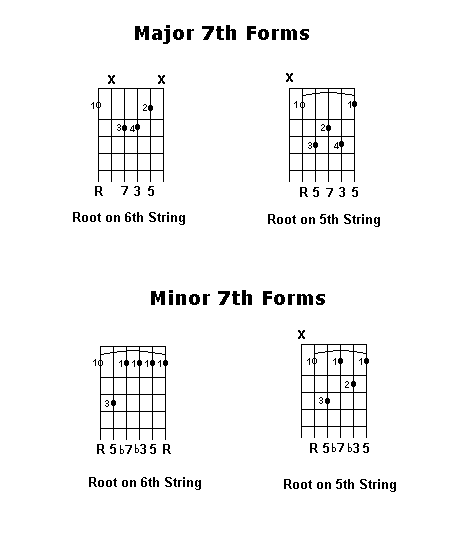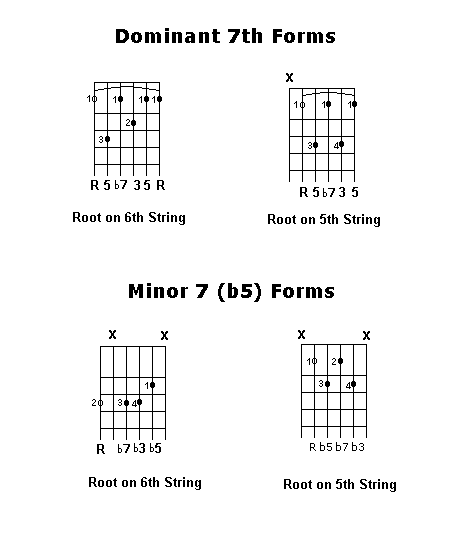Lesson 14: Diatonic Harmony - Part 2
Lesson Contents:
-
Harmonizing a Major Scale Again
-
7th Chord Formulas:
- maj. 7 --> R, 3, 5, 7
- min. 7 --> R, b3, 5, b7
- dom. 7 --> R, 3, 5, b7
- min. 7 (b5) --> R, b3, b5, b7
-
Essential Chord Forms - Part 2
- major 7th forms
- minor 7th forms
- dominant 7th forms
- minor 7 (b5) forms
-
Putting It All Together - 7th chords in all Major Keys
Harmonizing a Major Scale
In Lesson 11 we formed triads
using an A major scale by stacking a diatonic third and fifth above each note of the scale. In this
lesson we extend this logic and add diatonic 7ths to each triad. The result yields what are called
7th chords. 7th chords are most often used in jazz music for
their rich sounding harmony, but they exist in all styles of music.
Here is our A major scale again, but this time I have harmonized it to produce 7th chords:
 Again, a pattern emerges for all major scales (keys): The chords built on the 1st, and 4th
notes of the scale are major 7th chords. The chords built on the 2nd, 3rd, and 6th notes of
the scale are minor 7th chords. The chord built on the 5th note of the scale is a dominant
7th chord. And the chord built on the 7th note of the scale is a minor 7 (b5) chord.
Here are the diatonic harmonic representations for this pattern:
I maj.7 ii-7 iii-7
IV maj.7 V7 vi-7 vii-7(b5)
Again, a pattern emerges for all major scales (keys): The chords built on the 1st, and 4th
notes of the scale are major 7th chords. The chords built on the 2nd, 3rd, and 6th notes of
the scale are minor 7th chords. The chord built on the 5th note of the scale is a dominant
7th chord. And the chord built on the 7th note of the scale is a minor 7 (b5) chord.
Here are the diatonic harmonic representations for this pattern:
I maj.7 ii-7 iii-7
IV maj.7 V7 vi-7 vii-7(b5)
7th Chord Formulas
There are many 7th chords, but let's just look at the 4 that appear in major keys:
| Major 7: |
R |
3 |
5 |
7 |
| Dominant 7: |
R |
3 |
5 |
b7 |
| Minor 7: |
R |
b3 |
5 |
b7 |
| Minor 7 (b5): |
R |
b3 |
b5 |
b7 |
A few things are worth mentioning:
-
A major 7th chord and a dominant 7th chord both contain a major triad. The difference
between the two chords is this: a major 7th chord contains a major 7th interval while
a dominant 7th chord contains a minor 7th interval. For instance, a C major 7th chord
contains the following notes: C, E, G, and B whereas a C7 (a C dominant 7th chord,
pronounced "see-seven") contains the following notes: C, E, G, and Bb.
When it comes to the IV and V chords of a major key, an important observation is
needed to be made: the four-chord is a major 7th chord while the five-chord is a
dominant 7th chord. (Many players starting out seem to get confused by this for some
reason. Be sure you understand this distinction.)
- A minor 7th chord contains a minor triad.
- A minor 7 (b5) chord contains a diminished triad.
Essential Chord Forms - Part 1
Here are some esstential voicings for the 7th chords mentioned above. There are two voicings for each
chord type:
- ones that have a root starting on the 6th string of the guitar
- ones that have a root starting on the 5th string of the guitar


Putting It All Together - 7th Chords In All Major Keys
With the above chord forms you can now play any diatonic 7th chord for any major key. Here's a table
to help you along:
|
Key |
The Diatonic 7th Chords |
|
I maj.7 |
ii-7 |
iii-7 |
IV maj.7 |
V7 |
vi-7 |
vii-7(b5) |
| The Natural Key: |
C |
C maj.7 |
D-7 |
E-7 |
F maj.7 |
G7 |
A-7 |
B-7(b5) |
| Sharp Keys: |
| G |
G maj.7 |
A-7 |
B-7 |
C maj.7 |
D7 |
E-7 |
F#-7(b5) |
| D |
D maj.7 |
E-7 |
F#-7 |
G maj.7 |
A7 |
B-7 |
C#-7(b5) |
| A |
A maj.7 |
B-7 |
C#-7 |
D maj.7 |
E7 |
F#-7 |
G#-7(b5) |
| E |
E maj.7 |
F#-7 |
G#-7 |
A maj.7 |
B7 |
C#-7 |
D#-7(b5) |
| B |
B maj.7 |
C#-7 |
D#-7 |
E maj.7 |
F#7 |
G#-7 |
A#-7(b5) |
| F# |
F# maj.7 |
G#-7 |
A#-7 |
B maj.7 |
C#7 |
D#-7 |
E#-7(b5) |
| C# |
C# maj.7 |
D#-7 |
E#-7 |
F# maj.7 |
G#7 |
A#-7 |
B#-7(b5) |
|
Key |
The Diatonic Chords |
|
I maj.7 |
ii-7 |
iii-7 |
IV maj.7 |
V7 |
vi-7 |
vii-7(b5) |
| Flat Keys: |
| F |
F maj.7 |
G-7 |
A-7 |
Bb maj.7 |
C7 |
D-7 |
E-7(b5) |
| Bb |
Bb maj.7 |
C-7 |
D-7 |
Eb maj.7 |
F7 |
G-7 |
A-7(b5) |
| Eb |
Eb maj.7 |
F-7 |
G-7 |
Ab maj.7 |
Bb7 |
C-7 |
D-7(b5) |
| Ab |
Ab maj.7 |
Bb-7 |
C-7 |
Db maj.7 |
Eb7 |
F-7 |
G-7(b5) |
| Db |
Db maj.7 |
Eb-7 |
F-7 |
Gb maj.7 |
Ab7 |
Bb-7 |
C-7(b5) |
| Gb |
Gb maj.7 |
Ab-7 |
Bb-7 |
Cb maj.7 |
Db7 |
Eb-7 |
F-7(b5) |
| Cb |
Cb maj.7 |
Db-7 |
Eb-7 |
Fb maj.7 |
Gb7 |
Ab-7 |
Bb-7(b5) |
Go to the next lesson, Lesson 15, or go back to the
main menu.



